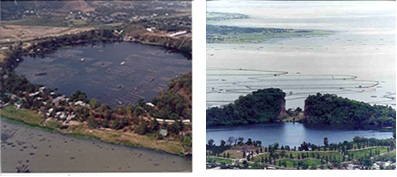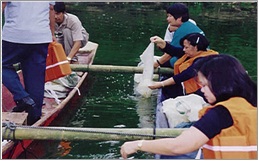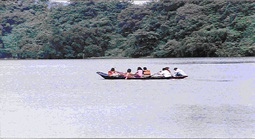Multi-Stakeholders’ Efforts for the Sustainable Management of Tadlac Lake, the Philippines
22.03.2012
-
SUBMITTED ORGANISATION :
-
International Lake Environment Committee Foundation (ILEC)
-
DATE OF SUBMISSION :
-
22/03/2012
-
REGION :
-
South-Eastern Asia
-
COUNTRY :
-
Philippines (Laguna Province)
-
SUMMARY :
-
Tadlac Lake is one of the eight crater lakes within the Laguna de Bay watershed. It was used heavily for aquaculture until the late 1990’s until a massive fishkill occurred in 1999. The crisis served as a catalyst for the community of Tadlac Lake to put all their efforts together in saving the lake from further deterioration. The cause was championed by the Barangay Council and the Barangay Fisheries and Aquatic Resource Management Council (BFARMC) who worked closely with the Laguna Lake Development Authority (LLDA) for guidance and supervision in mapping out strategies to ban aquaculture operation in the lake. The political will and determination of the Barangay Executives proved very successful in convincing the fish cage operators to stop their business operation and let the lake recover. Collaborative work with other government agencies was pursued to sustain the efforts in conserving the lake. Initial activities included the physical clean-up of the lake and voluntary dismantling of fish cages and huts along the lakeshore. The LLDA provided policy and program support by banning aquaculture in the lake and allocating manpower and financial resources to prepare the Tadlac Lake Master Plan, taking into consideration the proposed Tadlac Lake Nature Park prepared by the Barangay Council, the Barangay Tadlac FARMC and the NGO Ugnayan sa Los Baños (ULB). There is still much to be pursued due to changed priorities by the LLDA but the community never relents on their commitment to save the lake.
-
KEYWORD :
-
Sustainable management, political will, collaboration, multi-stakeholder involvement
-
AUTHOR:
-
Adelina C. Santos-Borja Chief, Research and Development, Laguna Lake Development Authority (LLDA) Crispina Malana-Muan Community Development Officer 11, LLDA Elrem B. Almero- Peña Community Development Officer 1, LLDA Matilde Erasga President, Barangay Tadlac Fisheries and Aquatic Resource Management Council
1. Background
Tadlac Lake and Environs
Tadlac Lake is one of the 8 crater lakes found within the watershed of Laguna de Bay, the largest lake in the Philippines (Figure 1). It is located in the Province of Laguna, specifically at Barangay Tadlac of the town of Los Baños, which lies at the foot of Mt. Makiling. Geographically, it extends from 14011’14” to 14010’56” north and 121012’10.2” to 121012’26.8” east. Tadlac Lake is separated from Laguna de Bay by a 50-meter wide strip of land at its eastern side. It is a very small lake with a surface area of 248,000 m2 and a mean depth of 27 meters. Lake overturn locally called as “langal” occurs once a year, normally during the months of December to February.
Figure 1: Map of Tadlac Lake
The lands surrounding the lake are privately owned. There are recreational facilities with swimming pools along the shore. Swimming in the lake is not so popular due to the sudden drop in its depth. Likewise, the legend of the lake speaks of a lady deity and it is a common belief that human life is taken as the lady pleases.
Barangay Tadlac has a total land area of 1,550,000 m2 (a barangay is the smallest political unit in the Philippines). Based on the 2003 survey, there are 570 households with a total population of 2,515. As a coastal town, the life of the people centers on deriving benefits from the lake and from the nearby Laguna de Bay (at the northwestern border). Business also thrives in the area in the form of small convenience stores locally known as “sari-sari” (variety) store. Tricycles are the major means of transportation in the area, thus there is a considerable number of self-employed drivers.
Aquaculture Operation
Tilapia fish cage culture started in the lake in 1986 (Figure 2). The Provincial Government of Laguna provided financial assistance to fisher folks of Barangay Tadlac who wanted to venture into aquaculture. Not long after the actual operation of the fish cage business, series of typhoons wiped out the stocks and the fish cage operators suffered severe losses. They looked for alternative financial source to recover and this paved the way for wealthy capitalists from other towns to enter into the aquaculture business. Aside from providing financial assistance with interest, they also put up their own fish cage structures, and along with them are the caretakers and their families. This resulted to a change in the structure of ownership. Some Barangay Tadlac residents who used to operate a fish cage of their own opted to be fish cage caretakers of the non-resident operators. The good economic gains from the business attracted more investors that led to the proliferation of fish cages. Suppliers of artificial feeds also became aggressive in promoting the utilization of their products in the lake. The deterioration of the lake’s water quality was not an issue then among the residents due to economic necessity.

Figure 2: Tadlac Lake with aquaculture structures
Lake Management Structure
The Laguna Lake Development Authority (LLDA):
The Laguna Lake Development Authority (LLDA), created in 1966 through an Act of the Philippine Congress (Republic Act 4850, as amended) is mandated to manage and develop the Laguna de Bay Region, where Laguna de Bay, the biggest lake in the Philippines, and Tadlac Lake, one of the crater lakes in Laguna Province are located. The General Manager heads the Authority and the policy making body is the Board of Directors. Local executives such as the Governor of the two largest provinces within the Laguna de Bay Region, namely Rizal and Laguna, and representative of the Mayors League of each of these provinces, are members of the Board.
In 1986, the LLDA approved the utilization of 30,000 m2 in Tadlac Lake for aquaculture, which is around 12 % of the total surface area of the lake.
The Local Government Units (LGU):
The LLDA has established strong partnership with the local government officials. Their important role in ensuring the protection of the environment was emphasized in the Local Government Code of 1991 or Republic Act (RA) 7160. One of the key features is the recognition of the need to have an environmental and natural resource officer in each LGU. Local governance in the Philippines covers the provinces consisting of different cities and municipalities, which are further divided into smaller political and administrative units called barangays. The latter is administered by the Barangay Council, whose members are also elective officials. The Barangay Chairman heads the council and is directly under the administrative jurisdiction of the town or city mayor.
The lakeshore municipalities receive financial support from the LLDA through the allocation of a certain percentage of the annual resource use fee that the LLDA charges from the operators of fish pens and fish cages in Laguna de Bay. From the fish pen fee of P 6,000 per hectare per year (US $ 107.00), a lakeshore municipality gets 15% and another 20% is added if there are aquaculture structures off their shores. The town of Los baños where Tadlac Lake is located gets 35 % or an average of PhP 350,000.00 per year (US$6,300.00).
The Fisheries and Aquatic Resource Management Council (FARMC):
Another environmental partner of the LLDA is the Fisheries and Aquatic Resource Management Council (FARMC). The creation of the council is also mandated by Philippine Law, first as an Executive Order (EO 240) in 1995, in accordance with the policy of the Philippine Government to “ensure that the management and control over fisheries and aquatic resources shall be effected through the active and extensive participation of people directly affected.” This EO was further strengthened and defined in 1998 through the enactment of the Fisheries Code (RA 8550). The Act specifically ordered the creation of a FARMC in the national level and in all municipalities and cities and their respective barangays abutting municipal waters with the assistance of the local government units (LGU) and other government entities.
The Barangay Tadlac FARMC is composed of members representing the fisher folks, the Barangay Development Council, the Chairperson of the Municipal Committee on Agriculture and Fisheries and the NGO based in the locality. The set of officers include a Chairperson, a Vice Chairperson, Secretary, Treasurer, Auditor, Public Relation Officer and Sgt.-at-arms.
Operational funds come in the form of donation, the first of which was the PhP 50,000.00 (US $1,100) given by the Filipino Community in Thailand to the predecessor of the FARMC, the Barangay Tadlac Resource Management Council, with the assistance of Ugnayan sa Los Baños (ULB), an NGO working in the area. The money was used to construct a fish landing in the lake, which also serves as a multi-purpose facility such as for meetings and for picnics.
The Municipal Government of Los Baños also extends financial support to the FARMC by allocating the fish pen fee share it gets from the LLDA to be used for the various projects of the Municipal FARMC. This is covered by Municipal Ordinance 2001-10, which specifically allots 10% each to the FARMCs of the five lakeshore barangays, one of which is Barangay Tadlac.
The LLDA in collaboration with other government agencies provides institutional development support in the form of trainings and seminars on environmental monitoring, stewardship, management and project development. In partnership with the Bureau of Fisheries and Aquatic Resources (BFAR), paralegal training is also given leading to the deputation of FARMC members as fish wardens. Program support comes through the provision of fingerlings for lake seeding and food allowances for volunteers in lake clean-up activities, such as the manual harvesting of water hyacinth, removal of abandoned fish pen and fish cage materials, and the collection of organic and inorganic debris.
2. Issues and Conflicts
Lack of focus in Managing the Lake
The LLDA assumed its jurisdiction in Tadlac Lake in 1986, which was also the time when controversies and conflicts related to the proliferation of fish pens in Laguna de Bay became very serious. Most of the attention was focused on the bigger lake and due to lack of manpower, there was very limited presence of LLDA personnel in Tadlac Lake. The original area allocation of 30,000 m2 for aquaculture was exceeded and the fish cages almost filled up the whole lake.
During this period, the privately-owned hill found at the northeastern side of the lake was quarried and went on almost unopposed by the community (Figure 3). There was no serious intervention on the part of the government to stop the activity due to the lack of presence of the LLDA and the recognition of the local government of Los Baños of the right of the land owner to develop his property. Likewise, the Philippine Environmental Impact Assessment System was not yet fully in placed at that time. About 7,000-8,000 m2 of land was flattened and the quarried earth was used as filling materials for the development of the private recreational facilities along the lake and as raw material for the manufacture of hollow blocks used in the construction of buildings and houses. The “broken mountain,” as it is conveniently referred to, has some beneficial use since it allowed easy access to the neighboring barangay.
Figure 3: Quarried Hill Found at the Northeastern Side of the Lake.
In 1992, the LLDA started asserting its mandate over Tadlac Lake. A Memorandum Circular was issued to regulate the use of the lake for aquaculture including the reduction of the fish cage area to conform to the limit. During this time, the Resource Management Council of Tadlac Lake was already formed and the LLDA coordinated closely with them in the formulation of guidelines and criteria for the selection of 150 qualified fish cage operators to be awarded with an area of 200 m2 each. Reduction of fish cages was not completely implemented in view of the appeal of the fisher folks for reasonable period to recover their investment. Likewise, some of the RMC members were fish cage operators themselves. Unfortunately, the reasonable period was not well defined, until eventually, the desired reduction in fish cage area did not happen.
The frequent change in the leadership of the LLDA and the lack of involvement of the LGUs were also some of the reasons why there was lack of focus in the efforts to sustainably manage Tadlac Lake. The LLDA General Manager (GM) is a political appointee, thus, in every change in the President of the Philippines, a new GM is appointed. More often than not, a new GM would have different set of priorities from his predecessor in the implementation of plans and programs in the Laguna de Bay Region.
Poor Economic Condition of Fisher Folk
Barangay Tadlac is a fishing community. For some, fish cage operation is the only source of livelihood. This is one of the reasons why the reduction of fish cage area to the set limit never became successful. There was no alternative livelihood offered by the government. Likewise, there was displacement of the barangay fisher folk due to the entry of investors from other towns.
The Ugnayan sa Los Baños, pursued the organization of a fisher folk cooperative. The assistance of the Philippine Council for Aquatic and Marine Resources and Development (PCAMRD) was sought to adopt Barangay Tadlac as one of the demonstration sites for the development and promotion of a community based economy project. Unfortunately this initiative did not push through due to the occurrence of massive fish kill in December 1998, which further extended to February 1999.
Deteriorating Water Quality
Before the introduction of aquaculture, Tadlac Lake is considered as an oligotrophic lake which undergoes annual overturn. During this period, which is locally called “langal”, some indigenous fishes in the lake were often observed gasping for air near the lake surface. The eutrophication of the lake started when the demand for artificial fish feed increased. Being a closed lake with very minimal water movement due to its morphometric characteristics, the water quality started to deteriorate due to the decomposition of unutilized feeds and the organic wastes coming from fish excreta. Thus during lake overturn which normally occurs during the colder months (December to February), the effect of this phenomenon is often magnified due to the high mortality of cultured fish. This also reflects the effects of environmental abuse. Increased organic loading in the lake aggravated the situation that resulted in a deficit in the supply of dissolved oxygen (DO) and the release of anaerobic and toxic gases from the deeper portion of the lake. This was duly reflected in the water quality analysis done by the LLDA during fish kill period where the DO was less than 3 mg/L.
In spite of the losses incurred during fish kills, the operators still continue to operate their fish cage, often with big loans from capitalists. The need to reduce the number of structures and to arrange the fish cages to allow for some water movement was not given consideration out of necessity to recover their economic losses. Others that could no longer recover and has no means to access credit facilities reverts to subsistence fishing in Laguna de Bay.
3. Partnership and Collaboration
Finding Opportunities in Problems
The reduction of fish cages in the lake to meet the 30,000m2 limit has long been a struggle by the LLDA and the then RMC. In 1997, upon the recommendation of the latter, the LLDA issued another order banning the new construction of any structure in the lake and its immediate surrounding and prohibiting illegal fishing activities. By April 1998, the total area in the lake occupied by fish cages was 58,700 m2, which was unevenly distributed to 57 owners. This was the situation when the massive fish kill occurred during the annual lake overturn in 1999. By February, all the stocks were completely wiped out and the lake was full of floating dead fishes.
This was the worst fish kill in the lake. Lost of investment was around PhP 4,000,000.00 (about US$100,000). The situation alarmed the community and concerted action was organized to clean the lake of floating dead fishes. Through the collective efforts of volunteers from different sectors such as the FARMC, Barangay Tadlac Council, Ugnayan sa Los Baños, the Philippine Army through the Military Reservist “B” Coy, the LLDA and other government agencies such the local office of the Department of Environment and Natural Resources, the Philippine Council for Aquatic and Marine Research and Development, and other residents, a one-week clean up activity was undertaken. Everything was done in the spirit of “bayanihan” a Filipino culture where group of people voluntarily extend their assistance to those in need of manpower and logistical support so that something can be achieved.
The fish kill served as an “eye opener” for the Barangay Tadlac Community. The Barangay Council, through its head, the Barangay Chairman and the FARMC talked to the fish cage operators and appealed to them to give the lake a “time to rest” (pagpahingahin and lawa in the dialect) and recover. An alternative site offered for aquaculture is Laguna de Bay since the fish cage belt off the waters of Los Baños is not yet fully occupied. The Province of Laguna also gave financial assistance to those who would like to start anew, provided it would not be in Tadlac Lake but in Laguna de Bay and that the necessary permit from the LLDA is secured.
Through the perseverance of the Barangay Council, the FARMC, the Ugnayan sa Los Baños and the LLDA, the fish cage operators agreed to stop their business in the lake. Sustained “bayanihan” work continued until March 1999, this time including the demolition of structures left by the fish cage owners both in the water and along the lakeshore (Figure 4). They also initiated a fund raising drive dubbed as “Tulong para sa Tadlac” (Help for Tadlac) for the clean up activities with a slogan “Pahingahin ang Lawa” (Let the lake rest).
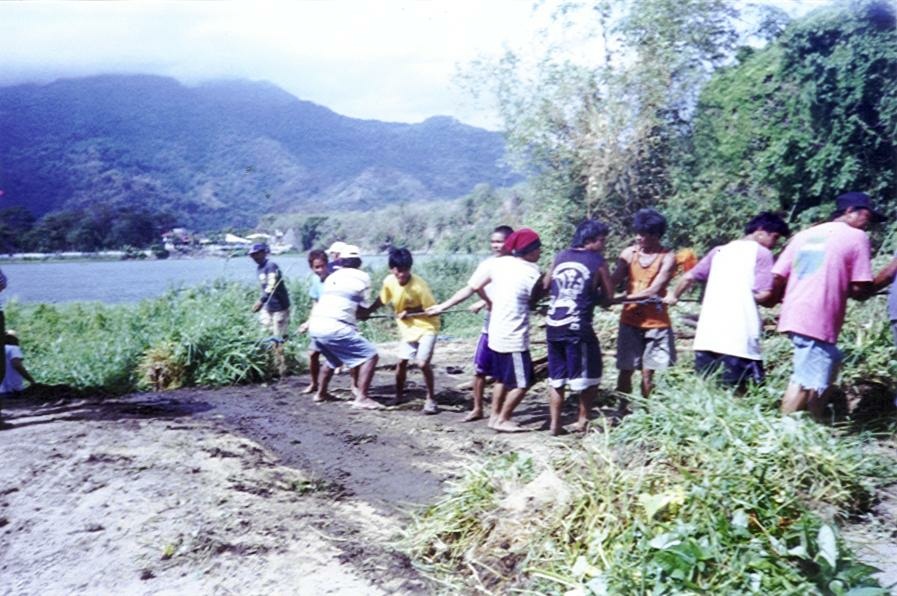
Thus, what the LLDA and the FARMC have been trying to achieve in the past years, which is the reduction of fish cage area to only 30,000 m2, was surpassed by totally getting rid of any aquaculture structure in the lake (Figure 5). The determination of all sectors, particularly the Barangay Council and the FARMC made the big difference. The fish kill problem became an opportunity towards working for the sustainable management and development of Tadlac Lake.
Figure 5. Tadlac Lake Before and After the Successful Concerted Efforts to Ban Aquaculture
4. Actions and Strategies
With the heightened dedication and the encouraging results from concrete and collective actions of all the concerned sectors, more activities were undertaken either in close collaboration or under the supervision of the LLDA.
Policy support and Environmental Regulation
Foremost among the policies enacted by the LLDA Board as a result of the “Pahingahinang Law” campaign was the ban on aquaculture operation in Tadlac Lake, initially for two years, through Board Resolution No. 140, Series of 2,000. The use of illegal fishing gears and construction activities in and along the lake are banned. The FARMC and the Barangay Council were tasked as monitors and they report any violation to the LLDA for appropriate legal measures on violators.
With the removal of aquaculture operation in the lake, the LLDA in consultation with the Bureau of Fisheries and Aquatic Resources (BFAR), embarked in a lake seeding program, provided that the fish species to be seeded are those that do not breed in the lake, like carp and milkfish. This is more for proper population control and recording of harvested fish upon maturity. Regulated fishing was also imposed until such time that the fish are ready for harvesting. Guidelines were set once the open season for fishing commenced. Each fisher folk family will be allowed to fish at specified limit per day and the catch will be recorded by the FARMC.
Program Support
Lake seeding (Figure 6) was done on 26 July 2000 with the slogan “Punla sa Lawa” (Seed in the Lake). This was widely supported and participated by the officials of the LLDA, the Provincial Governor, the town mayor and representatives of other government agencies. The occasion was also taken as an opportunity to witness the signing of the deed of donation by the owner of the quarried mountain of a 4-m right of way from his property to the lake.
Figure 6: Lake Seeding
The FARMC became more vigilant in monitoring any violation in fishery laws and was also tasked to record any fish mortality. Unfortunately, lake overturn again occurred in December 2000 which caused high fish mortality and forced the FARMC to harvest whatever they can. Since then, lake seeding has been an annual activity in Tadlac Lake and is scheduled early in the year to enable the fish to mature before the onset of lake overturn.
The FARMC and the members of the Barangay Council were also trained to conduct water quality monitoring and analysis by the use of simple water quality testing kit (Figure 7). This was done to prepare them to do immediate analysis during fish kill since the LLDA laboratory is based near Manila which is very far from Tadlac Lake.
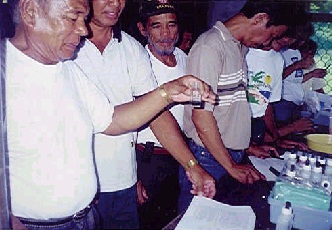
Figure 7: FARMC Members Were Trained on Water Quality Monitoring & Analysis.
Various species of trees were planted along the lake to prevent erosion and discourage temporary human settlement. Regular lake clean up activities are being undertaken, the most recent of which was from May 4-6, 2004. The LLDA, the FARMC and the Tadlak Barangay Council shared their resources to clean the lake of “floating island,” which consists of grass (locally called baret), wood and other materials where the grass could grow.
Tadlac Lake Nature Park
The Barangay Tadlac Council and Ugnayan Los Baños came out with a plan to develop the lake and the surrounding area into an Enchanted Lake Nature Park in consideration of the folklore about the lake. However, the name was changed to Tadlac Lake Nature Park to highlight the real name of the lake and the barangay. The plan was presented to the LLDA General Manager and to the Chairman of the Committee on Environment of the Municipality of Los Baños in the year 2000. Due to the popularity of the plan both to the community and the LLDA, the latter allotted a budget of PhP 1,000,000 (US $20,000) for the preparation of the Master Plan for Tadlac Lake. In connection with this, a visioning and planning workshop was organized by the LLDA on September 5-6, 2000. This was participated by the officers of the Barangay Tadlac Council and the Barangay Tadlac FARMC, representatives from the municipal government and from the LLDA. The vision and actions were anchored on the four major considerations for a successful ecotourism destination program for Tadlak Lake, namely: a) environmental protection and enhancement, b) people participation and empowerment, c) financial viability and d) project management with systematized and structured institutional arrangement.
The preparation of the Tadlac Lake Master Plan was given priority by the LLDA taking into consideration the proposed TLNP and the result of the workshop. In 2001, People Power brought a sudden change in the Executive Branch of the Philippine Government, and a new President was installed. Consequently, there was also a change in the leadership of the LLDA. The appointed General Manager had different priorities and Tadlac Lake was not one of the most urgent ones. It was during this time when major projects in the Laguna de Bay Region involving international funding support were initiated. Nonetheless, except for the preparation of the Master Plan of Tadlac Lake, the existing programs were continued.
4. Benefits and Future Perspectives
Despite the limited financial and manpower resources of the LLDA, the integrated multi-sectoral approach for the sustainable management of Tadlac Lake has been considerably successful. The community has shown keen awareness on the proper use of the lake through self-adopted practices. With Laguna de Bay as an alternative site for livelihood, there is less dependence on Tadlac Lake for daily subsistence of fishermen. Likewise, the Barangay Tadlac community has long explored other means of earning a living. The younger generation through proper schooling is becoming professionals in their own right and finding work in other places.
Since the massive fishkill in 1999, Tadlac Lake has been transformed into a clean and tranquil lake and people are now enjoying its aesthetic beauty (Figure 8). What is more impressive and appealing is the important role played by the community leaders in convincing the fish cage operators to leave the lake. The case of Tadlac Lake has become a favorite example of a successful community based resource management approach and a classic case of the importance of partnership among the different stakeholders in lake conservation, development and management.
Figure 8: A Clean and Tranquil Tadlac Lake
As a proof of recognition, the Barangay Tadlac FARMC was one of the recipients of the Philippine Wetland Conservation Awards (Figure 9) given during the World Wetlands Day Celebration in February 2004, with a modest price of PhP 50,000.00 (US $1,000). On the international front, the invitation by UNEP-IETC to present the case of Tadlac Lake in the Symposium celebrating Earth Day and its 10th anniversary speaks for the modest achievement of all sectors that transformed the lake into what it is today.
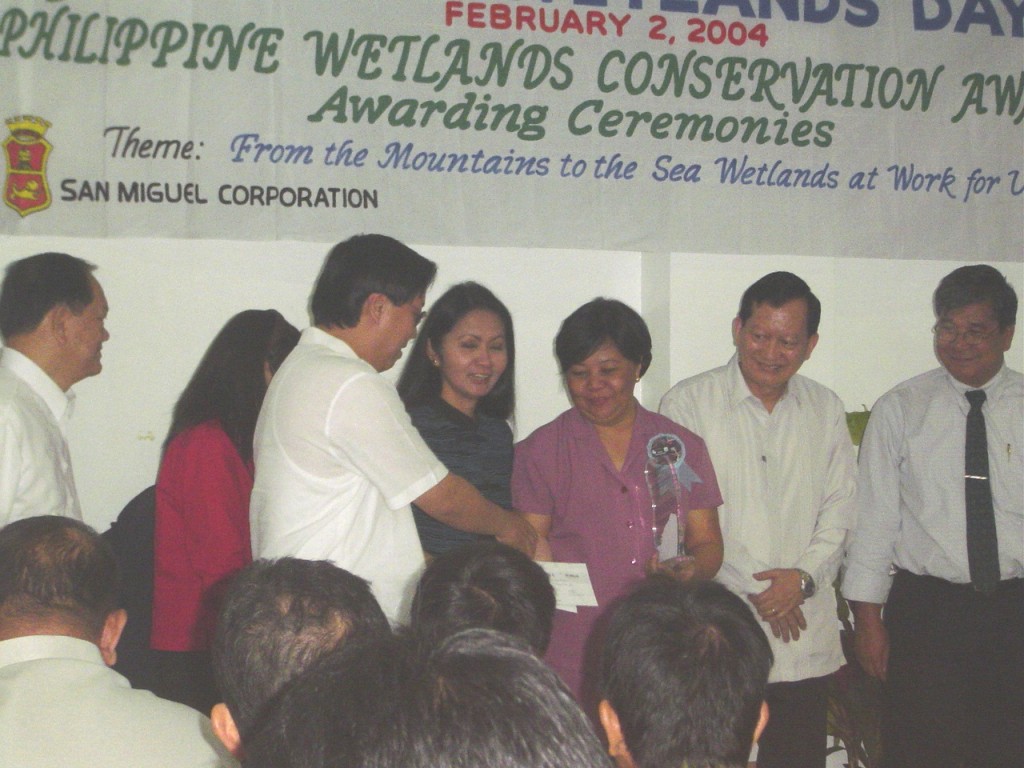
Figure 9: The President of the Barangay Tadlac FARMC receiving the Philippine Wetlands Awards from the Secretary of the Department of Environment and Natural Resources and Unilever Philippines
The barangay is also visited by different local government units and people’s organization from different parts of the Philippines to learn about their achievement in co-managing with the government a small lake, with the prospect of replicating what they have done in their respective town or community.
The town of Los Baños has also chosen Barangay Tadlac as the Pilot Barangay for solid Waste Management Program. The community takes pride that their barangay has become a demonstration site of laudable programs of the government.
The FARMC and the NGOs, together with the Barangay Council are hopeful that with the new General Manager of the LLDA, it would just be a matter of time before it renewed its commitment to lead in the preparation of the Tadlac Lake Master Plan. The community has identified themselves as major players in the development of Barangay Tadlac and Tadlac Lake. The LGU of Los Baños is very supportive and has likewise envisioned Tadlac Lake as a world class ecotourism destination and one of the major sources of income and employment for the community.
Even if the LLDA maintains a sustained interaction and communication with the community and is continuously pursuing certain programs in the lake, there is a need to honor its commitment at the soonest time possible to provide the financial and manpower resources to carry out the preparation of the Tadlac Lake Master Plan, a fitting recognition to the remarkable efforts and achievements of the Barangay Tadlac community.
Bibliography
Abaquita, A.L., Acedera, M.M., Baradas, F.C., Mendoza, R.C., Morante, R.L., Plopino, R.F., Santos, E.P, and Torres, A.M. 2000. Community Development Plan for Barangay Tadlac. Paper submitted to Dr. Federico Cruz, University of the Philippines at Los Baños, as a requirement in CED 252, 2nd semester, SY 1999-2000.
Barangay Tadlac Council and Ugnayan sa Los Baños. 2000. Development Plan for Tadlac Lake Nature Park.
Barangay Tadlac Integrated Development Plan, 2002-2003. Barangay Tadlac, Los Baños, Laguna.
Laguna Lake Development Authority – Community Development Division. 2003. List of FARMC Officials.
Muan, C. M., After Activity Reports in Tadlac Lake from 1999-2003. Lake Management Division, Laguna Lake Development Authority.
Reyes, D.B. and Pablo, B. 1998. Report on Ground Checking of Aquastructures in Tadlak Lake. Lake Management Division, Laguna Lake Development Authority.
Santos-Borja, A.C. 2000. Community Initiatives in Resource Rehabilitation and Conservation. Lecture given at the Trainor’s Training on Inland Resource Management, Bureau of Fisheries and Aquatic Resources, Tanay Rizal.
Santos-Borja, A.C., Calixto C.R. and Lopez, C. 2002. Building Alliances for Sustainable Management: The Laguna de Bay Experience in Proceedings of International Symposium on Building Partnerships between Citizens and Local Governments for Sustainable Lake Management. IETC Freshwater Management Series No.3. UNEP-IETC, ILEC and Shiga Prefectural Government, Japan.
Sumangil, J.H.Jr., Latay, E.M., Nuque, F.L., de Jesus, R., Principe, L.R., Gaza, J.R. and Tidon, S.G. Municipal Ordinance No. 2001-10. Los Baños, Laguna.




